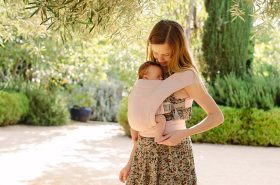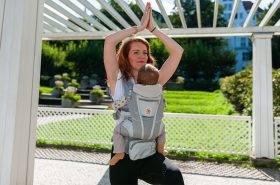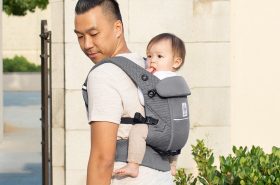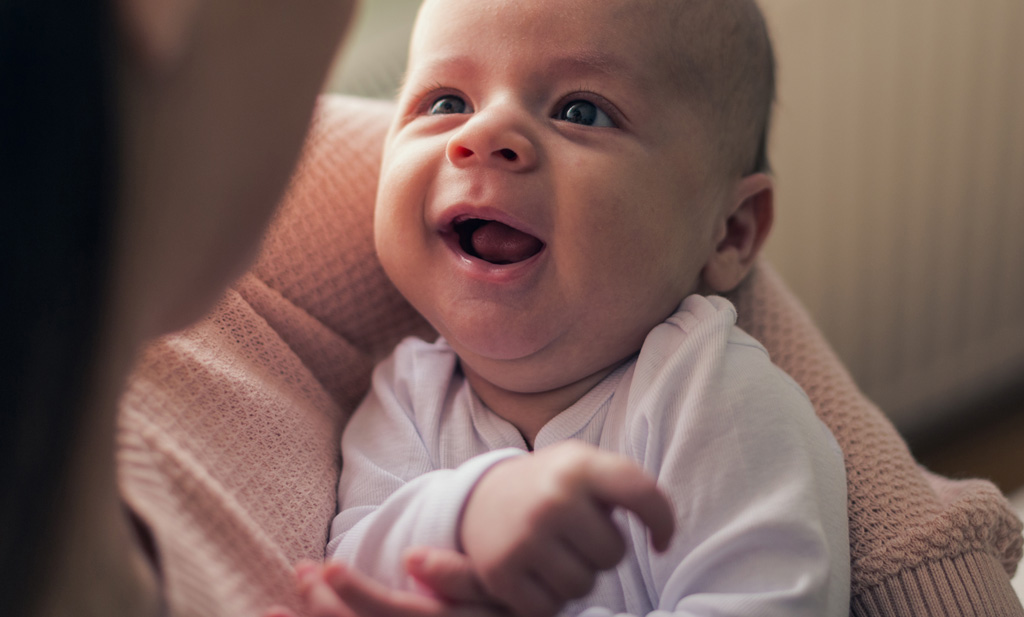
How babywearing, breast/chestfeeding and co-sleeping can strengthen this bond
Bonding. A term that is probably buzzing around in the heads of many expectant parents. Some have already dealt with it intensively and know the importance of bonding with baby and how they plan to do it. Others may worry that they will not be able to build a good and healthy attachment relationship with their baby. And others haven’t thought about it much at all.
Our babywearing survey, which we conducted together with babyforum.at in summer 2023, focused precisely on this bonding process and the question of what role a baby carrier plays in this. The result of the survey: 95.5 per cent of respondents who already have children stated that they had used a baby carrier or wrap to build a bond and closeness with their baby. You can find out more about this in our blog article “Babywearing benefits: why carry your baby?”. At 91.2 per cent, breastfeeding was in second place as a means of bonding, followed by co-sleeping or the family bed (86.1). Half of the families surveyed practise baby-led weaning (51%) and around a third breastfeed in a baby carrier (36.4%) for better bonding.
Strengthening the bond with your child: What is bonding?
We will go into more detail later on about why the families in the babywearing survey seem to have intuitively done everything right to strengthen their bond with their child. First, we want to know: what is an emotional attachment anyway? What is behind this term, which is so closely associated with parenthood? And what is the importance of bonding with baby? To explain this, let’s first find out the difference between bonding, bonding behaviour, and attachment.
Let’s start with a few terms to shed some light on the subject. You’ve probably heard one or two of them before. “Bonding” (bond = relationship) describes the process or behaviours that help lead to an emotional connection (attachment). A secure attachment ensures the child’s survival and therefore the main attachment figure (often the birthing parent) should always be sensitive, recognise the signals of their child, interpret them correctly and respond appropriately and promptly. This includes your willingness to emotionally engage with your offspring, nurture them according to their needs and provide them with protection and security. On the part of the child, this is more of a security system. As you can see, both parties have different needs and motivations when it comes to contact.

And, after you as parent/s, there are also other attachment figures who are further down the attachment pyramid according to their importance (but who are of course also important) e.g. grandparents, relatives, or other caregivers e.g. childminders, nursery staff etc.
How does a bond develop?
Immediately after birth, a newborn baby immediately recognises the birthing parent’s voice and smell and can already crawl to the breast / chest on their own. The person the child chooses as its main attachment figure is easy to predict and does not depend on chance. The person who reacts with the greatest sensitivity to the child in the most diverse interactions has the greatest chance of gaining this position.
The attachment researcher Bowlby (1969) categorised attachment development into four phases:
- Pre-phase – This phase covers the period from birth to the sixth week of life. During this time, the newborn shows its attachment behaviour towards every person.
- 2nd phase of the developing bond or the person-differentiating phase – From the sixth week to the sixth or eighth month of life, the infant’s reactions to familiar people become increasingly specific. It shows its first person-centred smile and develops an increasingly strong bond with one or more people (e.g. mother, father, siblings or foster mother).
- 3rd phase of strong bonding or actual bonding – In the period from six or eight months to one and a half to two years, the specific bond with the attachment figure finally develops. The baby can now move around on its own and either seeks proximity to its attachment figure or explores the environment independently with increasing object permanence. This is also the phase in which the baby or toddler begins to feel alienated. It protests when separated and endeavours to make active contact with its caregiver.
- Reciprocal relationship phase or goal-corrected partnership – The final bonding phase begins from the age of 1.5 to two years. In this phase, the child tries to influence the behaviour of the other person depending on the situation. It can now also draw on a wealth of attachment experience and is able to accept separation from attachment figures. If it draws on positive experiences, the child knows that the attachment figure is available, even if they are not present.
Strengthening your bond with your child over the years
In their first year of life, your child will build up an emotional relationship with you by intuitively demanding that their needs are met time and time again. If they experience negative feelings such as fear, disappointment or grief, they cry, cling or scream so that a caring person – you – can dispel these feelings. And you, in turn, intuitively react correctly to this behaviour. You usually recognise your child in this situation, take them in your arms and calm them down. This is called an intuitive parenting programme.
If your child learns during this phase that they will receive attention and care from you when they display their attachment behaviour, they will feel secure. They will increasingly assume that they will also experience this positive need fulfilment in other situations. Conversely, you unconsciously reinforce your own nurturing behaviour because you notice how this has a positive effect on your child’s attachment behaviour. This back and forth, this give and take, therefore helps to strengthen the bond between you and create a trusting and secure attachment.
What different types of bond are there?
However, the bonding process is not always identical. On the contrary. The individual bonding behaviour of a newborn always adapts to the behaviour of the respective caregiver and is shaped most strongly in the first six months. This means that the better and more promptly you respond to your baby’s needs, the more stable the bond will be. This results in the following four attachment styles according to Ainsworth (1978), which were determined with the help of separation and reunion phases:
The secure attachment style
A child with a secure attachment misses its attachment figure during a separation situation and may even start to cry. A stranger cannot fully comfort the child. The child is delighted when the attachment figure reappears. This is seen as a secure base from which the environment can be discovered – hence the name secure attachment style.
The insecure/avoidant attachment type
This type makes hardly any distinction between the attachment figure and the stranger. Separation from the former hardly worries the child. If the latter then re-enters the room, the child avoids contact or interaction with the attachment figure.
The ambivalent-insecure attachment type
Even before a possible separation, these children hardly leave their attachment figure’s side. If they are separated from the person, they react angrily or passively. If the attachment figure returns, they find it difficult to be comforted by them.
The disorganised-disoriented attachment type
The behaviour of these children is contradictory and unusual. For example, they literally “freeze” in their movements or perform the same actions repeatedly.
These different types of attachment can be recognised and differentiated very precisely at the end of the 1st year of life. Around 60-65% of all children develop a secure attachment to their mother and 55% to their father. In contrast, around 25% of children show an insecure-avoidant and 10% an insecure-ambivalent attachment to their mothers.
These attachment styles are relatively stable and are usually still evident in adult life. However, later positive experiences with attachment figures, for example, can influence and change a negative attachment style. At the same time, however, it has also been shown that parents generally pass on their own attachment experiences to their children. This means that insecurely attached children are more likely than average to have insecurely attached children again when they become parents.
How you can strengthen your bond with your child
So how can you positively support the development of your attachment? To build a secure and healthy emotional bond with your baby, you must always respond to their needs. Preferably always immediately and ‘correctly’. But this doesn’t mean if you are overwhelmed or dysregulated yourself, that you can’t take a second to calm down before you respond. It means respond as well as you can as often as you can. And don’t worry, you don’t have to take a course to do this, no, you usually display this behaviour intuitively. However, there are a few tools to help you with this. And these are exactly what the 6,652 participants in our babywearing survey used intuitively or consciously to strengthen their bond with their child.
Bonding thanks to baby carriers
Babywearing with a baby carrier, for example, enables constant physical contact with your baby. It is always with you and can hear your heartbeat, intensely perceive your odour, and hear your voice. At the same time, you can react immediately when your baby shows its needs. And fathers can also experience many intimate moments of bonding with the help of a baby carrier. Especially with our new Aura baby wrap, you can carry your baby skin-to-skin.
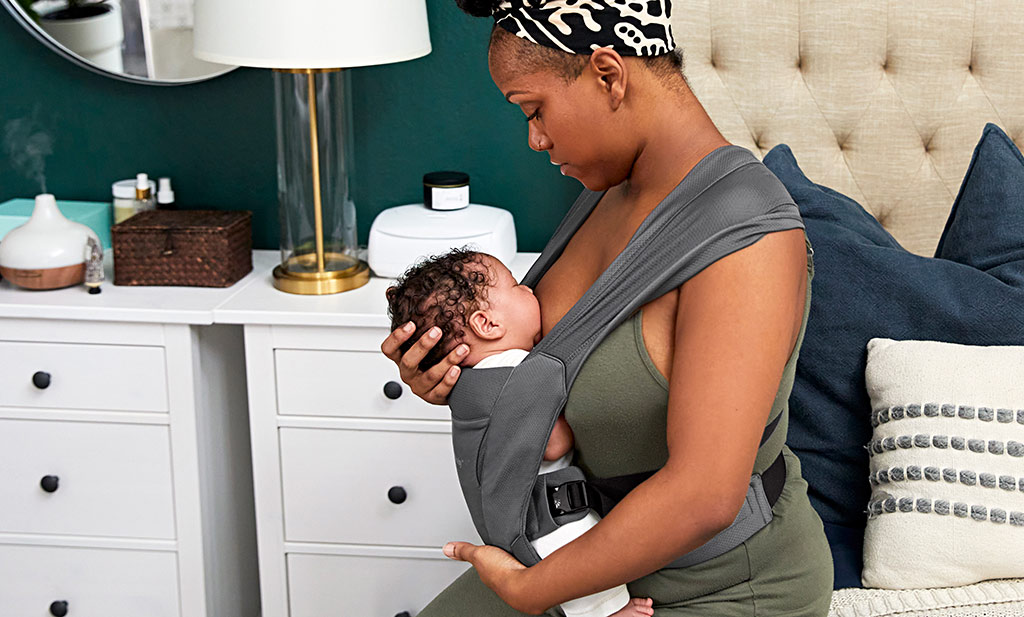
The most intense way of bonding is probably breast/chestfeeding. Here, physical contact is experienced skin to skin, while at the same time the need for “hunger” is satisfied. Incidentally, in our babywearing survey, half (54.6%) of all breast/chestfeeding parents stated that the baby carrier was used as an alternative to breast/chestfeeding as a means of bonding by the father or other carers within the family. Once breast/chestfeeding is established and if baby will take a bottle, you can try expressing milk from time to time if you like. Your partner or another caregiver can then feed baby while you have a little time out for yourself.
In third place in the babywearing survey was the family bed or co-sleeping as an aid to bonding. And once again, this fulfils everything we have mentioned so far. It promotes parents’ intuitive skills to be able to react promptly to the child’s signals in a way that is appropriate to their development and the situation.
Strengthening the bond with the child and forming a healthy attachment relationship
As you can see, the topic of bonding and attachment building is not something you need to worry unduly about. While the importance of bonding with baby is paramount, if you just listen and look carefully, it will mostly happen all by itself. The key thing to remember for building a healthy attachment relationship is “intuition”. The tools mentioned will also make one or two situations easier for you and you can respond to your little one and strengthen your bond with them. We hope you have lots of fun and enjoy “bonding”.
Source: SAFE, Sichere Ausbildung für Eltern, Karl Heinz Brisch, Klett-Cotta, 11. Auflage 2022

